T 3 Other Colligative Properties of Solutions
Ancient Romans are still admired today for their ingenious water system, engineered with a series of aqueducts and underground lead pipes. The upper classes enjoyed water delivered to their homes, just as we have today. What Romans didn't realize about their water, however, was that little by little the lead pipes were dissolving into it. And, consequently, the lead was ending up inside the Romans who drank the water. In this module, we'll look at what actually happens when a compound dissolves, why some things dissolve more easily than others, and how the Romans might have been able to use knowledge of solubility to remove the lead from their water.
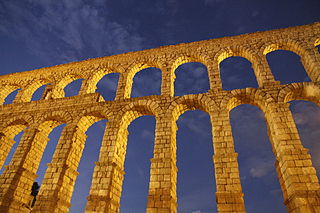
While researchers debate whether Rome's lead levels were high enough to cause widespread poisoning, one thing is certain: the Romans drinking that water couldn't see the lead in it. That's because the lead was dissolved as ions, much the same way that the sodium and chloride ions disappear into water when you stir table salt into it.
Still, the Romans' plumbing (from the Latin word for lead, plumbum, that gives rise to lead's symbol, Pb) was so clever that the system was adopted around the world. In the United States, many homes were built with lead pipes until the 1960s, and lead is present in some form in the plumbing of many modern buildings. In fact, lead is one of the chemicals most home water purifiers are designed to remove from our drinking water.
What does it mean to dissolve?
Some Romans questioned the use of lead pipes, noting that people who made the pipes and other lead items seemed to have a pale, unhealthy appearance. But even those concerned that lead was a toxin didn't have a precise way of measuring how much lead was in their water. Our ability to understand how much of a substance is dissolved into a given amount of water requires knowledge that grew over the centuries.
For starters, we need to consider what a solution actually is. The Properties of Liquids module describes a solution as a liquid with another substance dissolved in it. We use the term solvent for the liquid something is dissolved in, and the dissolved substance the solute. A solute can be either solid, liquid, or gas.
Many things that we drink are solutions containing substances dissolved in them, and sometimes we even mix those solutions ourselves. Electrolyte (or "energy") drink powders, for example, often contain the sugar called glucose and a variety of salts. Many athletes (and weekend warriors) will use these powders to make energy drinks when they are working out. When you add the drink powder to your water, the sugar and salts disappear. Both were solids, but they become dissolved in the liquid water and aren't visible anymore. The solids have separated into particles at the molecular level.
Comprehension Checkpoint
A solvent is _____.
Dissolving polar solutes in a polar solvent
Sugar and salt dissolve into water in different ways. Glucose, like all types of sugar, is a covalently bonded polar molecule, meaning that some parts of it have a slight positive charge and other parts a slight negative charge. Water is also a polar molecule.
In liquid water, areas of opposite charge on nearby water molecules are attracted to each other, creating what are called hydrogen bonds. Hydrogen bonds are strong attractions between charged atoms on separate molecules. They are strong enough to affect the properties of the liquid and its ability to dissolve certain types of solutes.
Glucose is a good example. When glucose and water interact, the positive areas of the glucose molecule are attracted to the negative areas of the water molecules, forming hydrogen bonds with the water molecules.
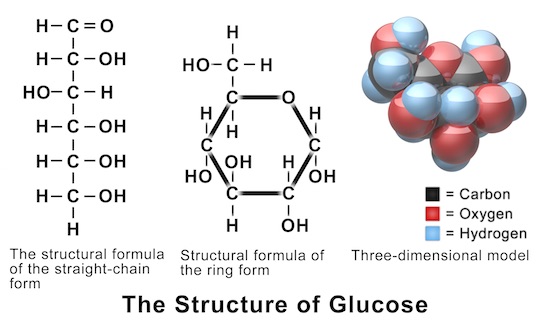
Similarly, the negative ends of the glucose molecule are attracted to the positive areas of the water molecules. In this way, the interaction allows the water molecules to surround each glucose molecule, separating them from their neighbors and dissolving them. If the solvent did not overcome the attraction between individual glucose molecules, they would clump together and remain undissolved. This is, in fact, what would happen if you tried to dissolve the drink powder in a non-polar solvent such as olive oil, rather than water.
Comprehension Checkpoint
Hydrogen bonds are formed by strong attractions between _____.
Dissolving ionic solutes in a polar solvent
Electrolyte drinks also contain NaCl and other salts, which provide ions your body uses when contracting muscles. These salt molecules have ionic bonds rather than covalent bonds and dissolve somewhat differently. Unlike covalent compounds, many ionic compounds break into their constituent ions in water. When the NaCl in the drink mix interacts with water, for example, the ionic bonds between the Na+ and Cl- ions are broken and the ions separate. They become distributed randomly and evenly throughout the solution. The surrounding water molecules form hydrogen bonds with the ions, which keeps the ions separated from each other.
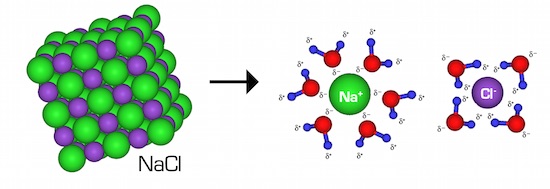
For all covalent and ionic compounds, the arrangement of water molecules around the solute particles keeps the solute from coming together again to form a solid—in other words, it's what keeps the solute dissolved. Therefore, the ability for these compounds to dissolve in water relies on charge and polarity.
Comprehension Checkpoint
When NaCl dissolves in water, _____.
Dissolving nonpolar solutes in a nonpolar solvent
Nonpolar solutes also dissolve in nonpolar solutions without breaking any bonds within the molecule. For example, if you're cooking, you can add some walnut oil to your olive oil for extra flavor. The molecules of walnut oil will mix in and become dispersed among the molecules of olive oil. As with polar solutions, the solvent molecules surround the solute molecules, but the attraction behind it is London dispersion forces (LDFs), rather than hydrogen bonding or ion-dipole interactions. LDFs are temporary forces formed when the electrons across two nearby atoms are unevenly distributed, resulting in a fleeting dipole-to-dipole attraction between the nearby atoms. These temporary attractive forces account for the dissolution of non-polar solutes in non-polar solvents. (See our Properties of Liquids module for more on intermolecular forces.)
Because LDFs are much weaker and temporary compared to hydrogen bonds, a non-polar solute will be much less likely to dissolve in water (or another polar substance). The LDFs between the non-polar solute and the polar solvent molecules are not strong enough to break the hydrogen bonds between water molecules (or other polar solvents). Thus, nonpolar solutes generally dissolve very little, if at all in polar solvents, and the opposite is also true.
This difference in solubility is often characterized by the phrase "like dissolves like." You can see this principle at work when you make salad dressing. Imagine you take your olive oil solution and mix it with a polar vinegar solution. You need to shake the dressing to mix it, and after a few minutes, the polar and nonpolar parts separate. That's because vinegar is a solution of water and polar acetic acid. The polar acetic acid and water molecules create hydrogen bonds with each other, but not with the nonpolar oil molecules. The oil particles are, in a sense, left out by the fact that they're not charged, and coalesce on their own, separate from the vinegar.

Comprehension Checkpoint
Nonpolar solutes dissolve more readily in _____ solutions.
Dissolving involves energy
The process of dissolving always involves a change in energy because of the bonds and intermolecular forces that are being broken and formed. This might mean that the solution needs to absorb energy from its environment, or it can also give off energy. Take, for example, a couple of common household items: baking soda, otherwise known as sodium bicarbonate, or NaHO3, and sodium carbonate, Na2CO3, a common ingredient in dishwashing powder. You can add a bit of either of these to a glass of water, and it will disappear. What might not be obvious is that when you dissolve the sodium bicarbonate, the water warms up slightly. And when you add the sodium carbonate, the water cools slightly. This is because dissolution of the baking soda results in a net release of energy, this energy flows into the system and warms the water. Dissolving sodium carbonate requires energy – thus cooling off the solution by absorbing energy from it.
Molarity: How much solute is in the solution?
Knowing what a solution is on a molecular level still doesn't tell us how many ions or molecules are dissolved in it. For that, we need to know the concentration, or number, of solute particles in a given volume of the solution.
Let's return to the example of electrolyte drink mix, but this time, let's say you want to make your own (much cheaper!). You're going to use glucose for energy and table salt, or NaCl for some of the electrolytes. The ideal flavor would be a sort of equal balance between sweet and salty. So, you weigh out 100g of glucose and 100g of NaCl, add them to your pitcher, and fill it up till you've got a liter. You give it a taste and discover it's terribly salty. How did that happen when you added the same amount of each?
The answer is that, while you added the same weight of each solute, you didn't add the same number of particles. To know the number of particles, we need to convert to moles.
As described in the The Mole and Atomic Mass module, a mole is a specific number of particles of a substance — 6.022 x 1023 particles, to be exact. The mole is a good unit for describing how many particles are in a solution, regardless of how much each particle weighs. Usually, when we are measuring quantities of a chemical, we just need to know the fraction of a mole we are using, rather than the exact number of particles.
Let's see how this works out with our electrolyte drink. One mole of glucose (C6H12O6) weighs 180 g. So to find the fraction of a mole we have, recall from the Moles unit:
Equation 1a
Doing the calculation:
Equation 1b
Doing the same for NaCl, which has a molar mass of 58 g/mol:
Equation 1c
As you can see, you've added over three times more salt than glucose. No wonder it doesn't taste so good!
Measuring concentration using moles per liter (moles/L) is more useful in chemistry than using grams per liter because it tells you how many particles of a substance you're dealing with. We call the measure of moles per liter of solution the molarity. A solution with 0.5 moles of glucose per liter of water is a 0.5 M (M is for "molar") glucose solution. Your solution is also a 1.7 M NaCl solution.
Let's say you try to get rid of some excess NaCl by pouring out half of the solution. Well, you'll be disappointed. You may have gotten rid of half of your NaCl ions, but you've also got only have the volume of water. The ratio of ions to water remains the same, therefore your concentration of NaCl remains the same.
Equation 2
This would be true for the glucose as well:
Equation 3
To add equal amounts of glucose and NaCl, you'd need to add the same fraction of moles to the liter of water. Let's say you want to add a half a mole of each:
Equation 4a
Equation 4b
There is a big difference in weight, but if you added 90g of glucose and 29g of salt you would have an equal number of particles. This example gives you an idea of why chemists use molarity, mol/L, to describe the concentration of solutions.
It's worth noting that, while you add 0.5 mole of NaCl, once the salt dissolves and the Na+ and Cl- ions have separated from each other, you will have 0.5 mole of each of them in the solution. In other words, you will have 1.0 mol of solute particles, half of them being Na+ and the other half being Cl-. This can be important when you're calculating the total molarity of a solution you create.
Comprehension Checkpoint
Molarity is measured in _____ per liter.
Solubility: A balance of forces
Some compounds, such as NaCl dissolve easily in water—pour a teaspoon in a glass of water, stir, and it's dissolved. The ability of a compound to dissolve in water is called solubility. Some substances are much more soluble in water than others. The solubility of a compound arises from the forces at work when adding solute to water.
The fact that sodium chloride dissolves so readily in water makes it great for our ion-detecting taste buds. Other types of salts (salts generally are compounds made of a metal and a nonmetal) wouldn't be nearly as good on your French fries. In silver chloride, AgCl, for example, the bonds between the two ions are much stronger. Pour a teaspoon of AgCl into a glass of water, and it will just sit there.
To understand why, we can compare what's happening on the molecular level. In the case of table salt, the ionic bonds holding the Na+ and Cl- ions together are weak enough to be easily broken by attraction to the dipoles of the water molecules, and the ions separate. Because they are oppositely charged, there is still attraction between them, but they are surrounded by water molecules. The attraction is not enough to draw many of them together in that situation.
The bond between Ag+ and Cl- ions is stronger, however. So when the silver chloride is in water, few of the ionic bonds will be broken. Even when they are, and when the ions become surrounded by water molecules, the pull of Ag+ and Cl- ions toward one another will be great enough to overcome the attraction of the polar water molecules.
In this way, the solubility of a compound is a balance of the two forces: the attraction between the molecules or ions of the solute (which hold the solute together) and the dipole-ion interactions between the solute and water molecules (which keep particles of solute apart from each other). In the case of AgCl, the interactions between the ions are stronger than the forces that might keep them apart. Most of the AgCl remains ionically bonded as a solid. In NaCl, the opposite is true: the attraction between the ions and the surrounding water molecules is stronger than the attractive force between the Na+ and Cl- ions. Most of the NaCl will dissolve into its respective ions.
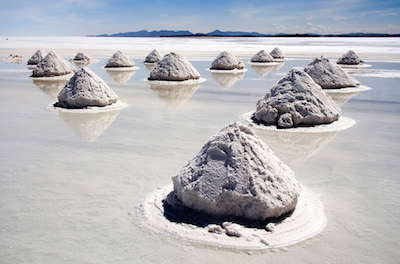
This is true up to a point—the saturation point. As you continue to add more and more NaCl to a solution, the ion concentrations increase and they are packed in closer and closer to each other. Eventually, there will be so many Na+ and Cl- ions, that some of them will be close enough to each other that the attractive forces between them will outdo the forces keeping them apart. The Na+ and Cl- will be drawn back together and reform as a solid, leaving undissolved grains of salt at the bottom of the vessel. (This is, in fact, what happens if you allow the water to evaporate, and the Na+ and Cl- ions become solid NaCl crystals again.) At this point, we say the solution is saturated, meaning that it can't absorb any more solute.
When adding walnut oil to olive oil, as discussed above, the two simply mix together. Once the solution is more than 50% walnut oil, the olive oil becomes the solute and the walnut oil the solvent. We say something is miscible when it forms a homogeneous mixture with another substance.
Comprehension Checkpoint
When a solution cannot absorb any more of a solute, it has reached its _____ point.
Solubility rules
As described earlier, the solubility of a compound is really the result of the balance of forces within and between molecules. But how do we know the result of that balance for a particular compound? Over the years, many different scientists have experimented with solubility, and some predictable patterns have emerged from their work. These patterns have been collected in a set of solubility guidelines (also called solubility rules) that are used to predict whether a compound will dissolve in water.
| Compounds containing: | Exceptions: |
|---|---|
| NO3 - | n/a |
| C2H3O2 - | n/a |
| CL- | Ag+, Hg2 2+, & Pb2+ compounds |
| Br- | Ag+, Hg2 2+, & Pb2+ compounds |
| I- | Ag+, Hg2 2+, & Pb2+ compounds |
| SO4 2- | Sr2+, Ba2+, Hg2 2+, & Pb2+ compounds |
| Compounds containing: | Exceptions: |
|---|---|
| S2- | NH4 + compounds, alkali metal cations, Ca2+, Sr2+, & Ba2+ |
| CO3 2- | NH4 + compounds & alkali metal cations |
| PO4 3- | NH4 + compounds & alkali metal cations |
| OH- | Alkali metal cations compounds, NH4 +, Ca2+, Sr2+, & Ba2+ |
These guidelines are very useful for chemical engineers, who are often devising products like fertilizer, drugs, and household goods. Such items are often most efficiently shipped as powders or solids but must be able to dissolve in water to be used. Consider powered laundry soap, for example. If it were simply powdered soap, it would get clumpy with changes in humidity. So manufacturers combine it with a naturally dry, flaky substance to prevent clumps and allow it to flow freely. That flaky substance also has to be soluble in water and not leave behind ions that might react and damage clothing, pipes, or the washer. The most common laundry detergent additive is sodium sulfate (Na2SO4). You can see from the chart above that all sulfates are soluble in water with the exceptions of those that form one of four different metal ions.
The solubility rules are useful in the other "direction" as well: in other words, let's say you have two solutions, each with different ions dissolved in them. The guidelines can help you predict whether mixing those two solutions will cause a reaction that produces an insoluble solid.
This could have been useful for the Romans if they'd wanted to get rid of the lead in their water. They would have been able to look at the chart and see that several ions will combine with lead to form insoluble compounds. An insoluble compound produced in reactions involving aqueous solutions is called a precipitate.
Here again, sodium sulfate can come in handy. The compound is found in many common rocks, and so the Romans probably had access to it. As you saw above, the solubility guidelines show that sodium sulfate is soluble in water. They also show that lead sulfate is not. Therefore, adding Na2SO4 to water that contains lead will produce a precipitate according to the reaction: Pb2+ (aq) + SO4 2- (aq) → PbSO4 (s)
And indeed, that reaction forms a cloudy white precipitate of lead sulfate that can be filtered out of the solution.
If a Roman chemist wanted to be sure they got rid of all the lead, they would need to know the molarity of lead in the water, and use an appropriate amount of sodium sulfate. Too little would leave dissolved lead behind, and too much would leave a lot of excess Na+ and SO4 2- ions, which could cause corrosion.
Comprehension Checkpoint
Precipitates are _____.
Colligative properties: concentration matters
Another reason that knowing the molarity of a solution is important is that it determines some of the solution's properties. For example, if you live in a snowy climate, you've seen trucks out spreading salt on icy roads. A little bit of the salt dissolves into the surface of the ice and creates a salt solution. This water with salt in it actually has a lower freezing point than water. Over time (and with cars driving over it), the salt dissolves into more and more of the ice, lowering its freezing point and allowing it to melt, creating safer driving conditions.
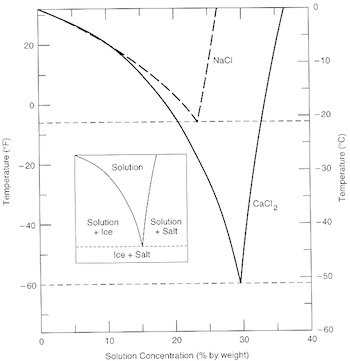
If you said that having more salt molecules dissolved in the water is what caused this change in freezing point, you'd be correct, but not exactly correct. It's not actually the concentration of solute that matters, but the concentration of solvent. And as more salt dissolves in the water, the concentration of salt goes up and the concentration of water goes down. IIt's this shift in the concentration of water that changes the properties of the solution. A less concentrated solvent will have a lower freezing point, and higher boiling point, and a lower vapor pressure. We call these properties that are affected by concentration colligative properties, (from the Latin words co – "together" – and ligare – "bind"). Colligative properties often relate to a state change, either from liquid to solid or liquid to gas. (See the States of Matter module for more on state change.)
Because these properties actually depend on the concentration of solvent, it doesn't matter what solute is added. If you find that a bit confusing, you're in good company. It took some very bright chemists about five decades to explain it.
Freezing point depression
In the early 1700s, the Swiss physicist chemist Daniel Bernoulli noted that concentrated salt and sugar solutions seemed to freeze at lower temperatures than pure water. He postulated that the solute particles in water somehow reduced the attractive forces between the water molecules, keeping the water from freezing until it had reached a lower temperature. He was curious about the phenomenon, but busy with other experiments and didn't pursue it further.
Some years later the English chemist Richard Watson, a follower of Bernoulli, also became curious about this phenomenon and wanted to quantify it. Does the freezing point shift in relation to which solute you add and how much of it? This wasn't a simple question to answer given that there was no refrigeration in the 18th century. Scientists at the time depended on the cold, snowy conditions of European winter.
Watson got a lucky break on February 12, 1771, when the temperature in his hometown of Cambridge plummeted to -14C. The resourceful chemist took advantage of this rare opportunity, and, no doubt shivering, tested the freezing points of 18 different salt solutions. His observations showed that the freezing point of a solution shifts downward in a way that varies with the concentration, regardless of the solute involved. This was a big step toward understanding freezing point depression, but Watson wasn't able to definitively quantify the relationship.
One of his contemporaries, Charles Blagden, carried out similar experiments on samples of water mixed with varying amounts of NaCl. Blagden, however, did not have the advantage of a particularly cold day, so he relied on snow and ice to chill his solutions. Blagden confirmed that the relationship between concentration and freezing point was inversely proportional. In other words, the higher the concentration of salt, the lower the freezing point. Because Blagden was making observations on only one salt (as opposed to many, as Watson had done), he was able to come up with a precise determination of how concentration affects the lowering of the freezing point. His discovery, which can be described mathematically using several different equations, is known as Blagden's Law. Blagden's Law quantifies what scientists before him had suspected—the presence of solute particles makes it harder for a solvent to coalesce and form a solid, and that forming a solid becomes harder in a way that's regular and predictable.
While it's easier to express this variation in terms of how many solute particles there are, it's important to remember that the number of solute particles, in turn, determines the number of solvent particles and that it's actually the concentration of solvent we're concerned about. We can explain this phenomenon at the molecular level by considering that when liquid water freezes, its particles come together in a regular, lattice-like arrangement. If all the particles are the same, it's relatively easy for a regular lattice to form. But when there are solute particles dissolved in the water, the water molecules are bumping into them, and therefore less likely to interact with each other. As the temperature cools, particles slow down and the attraction between water molecules becomes greater than the disruptive force of the solute.
Early American colonists cleverly used colligative properties to their advantage when making fermented apple cider (provided they had a cold winter day). They could ferment apple juice until they had a dilute alcohol solution. If they then set the fermented juice outside in the cold, pure water would freeze out of the solution. The fermented juice, with all that water removed, had a higher concentration of alcohol. Pour the solution out from the ice, and they had a drink called "apple jack," so named because the freezing process "jacked" up the concentration of alcohol.
Comprehension Checkpoint
A higher concentration of solute molecules makes it _____ for a solution to freeze into a solid.
Vapor pressure lowering and boiling point elevation
Solute concentration affects not only freezing point of a solution but also its boiling point and vapor pressure. Vapor pressure is a measure of the pressure created at the surface of a liquid as molecules of liquid evaporate. In any liquid in an open container, a small number of the molecules on the surface gain enough kinetic energy to escape the liquid and become gas. The more particles that escape, the higher the vapor pressure. For example, rubbing alcohol evaporates more quickly than water, and therefore has a higher vapor pressure.
In a container of pure water, the entire surface of the liquid is made up of water molecules, some of which are evaporating. When solute particles are mixed in to create a solution, however, those particles take up "real estate," and leave less room for water molecules on the surface. Fewer water molecules on the surface means fewer water molecules evaporating, which reduces the vapor pressure.
Vapor pressure is related to temperature, in that the warmer the liquid, the more molecules have enough kinetic energy to leave the liquid phase and become gas. As mentioned above, more molecules evaporating translates to a higher vapor pressure. As heat is added, eventually a solution reaches its boiling point. At the boiling point, there are so many molecules with enough kinetic energy to become gas that the vapor pressure is equal to the surrounding atmospheric pressure.
Therefore, it makes sense that because solute concentration affects vapor pressure, it also affects boiling point. If the vapor pressure of a liquid is lower in the presence of solute, then getting to the boiling point will require more energy or a higher temperature. This phenomenon is known as boiling point elevation.
Antifreeze in cars takes advantage of colligative properties to keep your engine at the right temperature. True to its name, solutes in the antifreeze solution lower the freezing point and keep the antifreeze (and your engine) from freezing up on very cold days. Those same solutes raise the boiling point, keeping your car from overheating on a hot drive through the desert.
Summary
Aqueous solutions are found throughout our world, and their chemistry depends in part on how much of a dissolved substance is in them. This module explores how substances dissolve, why some substances don't dissolve, and how we express the concentration of a solution. The module describes the forces that hold particles together and interactions that keep dissolved particles apart. It also examines how concentration affects freezing point, boiling point, and vapor pressure.
Key Concepts
-
A solution is formed when solute particles are randomly distributed and dissolved in a solvent.
-
Molarity is a measure of the solute concentration in a solution, and remains consistent when a fraction of the solution is poured off.
-
In polar solutions, the charges on both the solute and solvent particles keep the solute dissolved, as the polar solvent molecules surround the solute particles and keep them apart.
-
The relative solubility of a salt or polar compound in water is a balance of two forces: the attraction between atoms of the salt molecule, and the attraction between the ions and the water molecules.
-
Solutions of non-polar solutes in non-polar solvent are driven by London dispersion forces, another type of attraction between molecules.
-
Colligative properties of solutions—freezing point depression, boiling point elevation, and vapor pressure lowering—are related to the concentration of solute molecules but independent of the specific solute type.
T 3 Other Colligative Properties of Solutions
Source: https://www.visionlearning.com/en/library/Chemistry/1/Solutions-Solubility-and-Colligative-Properties/266
0 Response to "T 3 Other Colligative Properties of Solutions"
Post a Comment